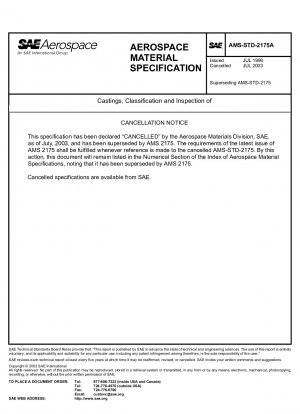SAE AMS-STD-2175A-2003
Castings@ Classification and Inspection of (AREA NDTI)
- Standard No.
- SAE AMS-STD-2175A-2003
- Release Date
- 2003
- Published By
- SAE - SAE International
- Status
- 2003-07
- Latest
- SAE AMS-STD-2175A-2003
- Scope
- "Purpose: The purpose of this military standard is to prescribe the non-destructive testing acceptance criteria for the inspection of metal castings that are classified (see 1.3) in accordance with this standard. Applicability: Casting methods: This standard is intended to apply to all casting methods except high pressure die castings (such as the ones covered by ASTM B 85@ ""Aluminum Alloy Die Castings""). Casting Alloys: This standard applies to casting alloys that fall under one of the alloy families covered in tables 6 through 14 of this standard. Alloys that do not belong to any of the alloy families covered in tables 6 through 14 may be inspected to this standard in accordance with 5.3.3.2. Classification: Castings that are inspected in accordance with this standard are classified by classes and applicable grades. This class governs the frequency of inspection (see 6.4)@ while the grade controls the quality of the casting. Classes: For design information only@ castings are classified as follows: a. Class 1. A casting@ the single failure of which would endanger the lives of operating personnel@ or cause the loss of a missile@ aircraft@ or other vehicle. b. Class 2. A casting@ the single failure of which would result in a significant operational penalty. In the case of missiles@ aircraft@ and other vehicles@ this includes loss of major components@ unintentional release or inability to release armament stores@ or failure of weapon installation components. c. Class 3. Castings not included in Class 1 or Class 2 and having a margin of safety of 200 percent or less. d. Class 4. Castings not included in Class 1 or Class 2 and having a margin of safety greater than 200 percent. Grades: Castings@ or sections of a casting@ shall be of grades A@ B@ C or D as shown in Tables 6 through 14 for radiographic requirements@ and table 4 for magnetic particle and liquid penetrant requirements. For design information only@ definitions for the grades are shown below: a. Grade A - The highest quality grade of casting@ or area of a casting@ with minimum allowable discontinuities and very difficult to produce except in local areas. b. Grade B - The second highest quality grade of casting@ or area of a casting@ which allows slightly more discontinuities than grade A@ and difficult to produce@ except in local areas. c. Grade C - A high quality grade of casting@ or area of a casting@ that can be consistently produced. d. Grade D - The lowest quality grade of a casting@ or area of a casting@ that is easily produced and is used primarily for low stress or noncritical areas adjacent to the higher graded areas."
SAE AMS-STD-2175A-2003 history
- 2003 SAE AMS-STD-2175A-2003 Castings@ Classification and Inspection of (AREA NDTI)
